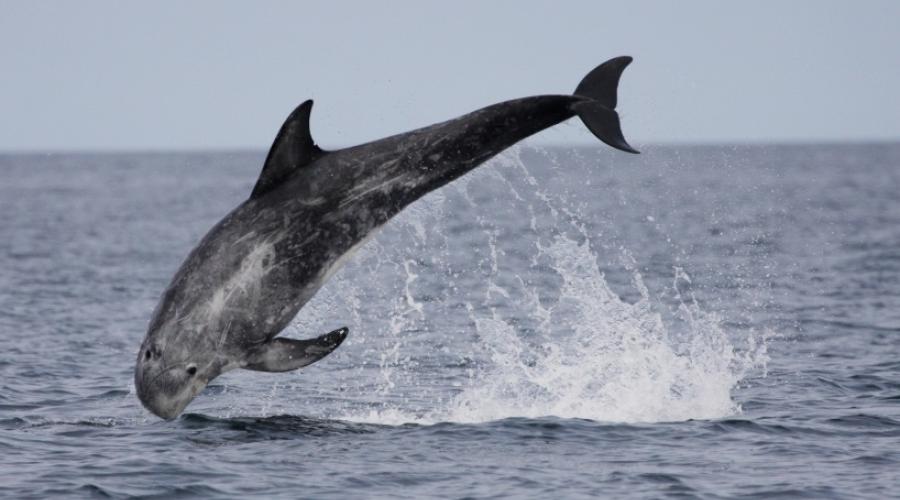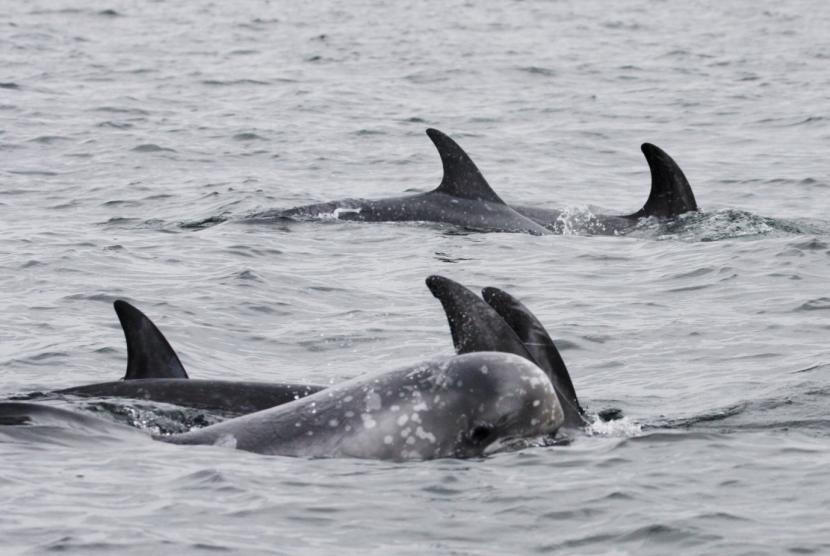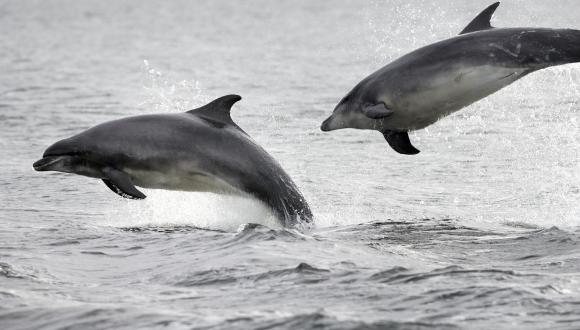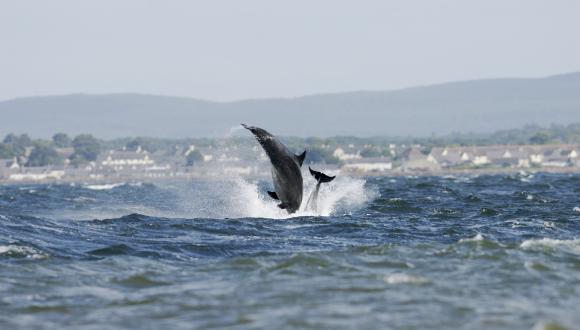
Risso's dolphin
Easily distinguishable from other dolphins due to the grey and white scarring on their bodies, Risso’s dolphins are a poorly known yet fascinating species thought to be at the northernmost extent of their range in Scotland’s waters.
Risso’s dolphin - Grampus griseus
The Risso’s dolphin is a large dolphin which grows up to 4 metres in length and can weigh as much as 500 kg. Generally, adult Risso’s are medium to dark grey on the back, paler on the sides and have a white anchor-shaped patch on the belly. The species tends to become whiter with age and is most easily recognised by the scars on its skin, particularly around their blunt, rounded head and mouth. The average lifespan of a Risso’s dolphin is between 20 and 30 years, with sexual maturity occurring between 8-10 years and a gestation (pregnancy) lasting 13-14 months.
Very little is known about the population structure of Risso’s dolphins in Scottish waters although typically groups of 6-12 individuals are observed. Scientific research from the Azores indicate that Risso’s dolphins have variable social structures which range from stable long-term groups to fluid groups prone to split and reform on a regular basis.
Risso’s dolphins are known to feed primarily on squid and octopus within the UK, although they also eat cuttlefish and various fish species.

Risso’s dolphin in Scottish seas
The majority of UK sightings of Risso’s dolphin occur along the west coast of Scotland and the Outer Hebrides. This apparent preference for the Outer Hebrides is likely to do with the abundance of prey and the closeness of the continental shelf where they also tend to feed. The abundance of Risso’s dolphin in Scottish seas is known to increase when their prey species, particularly squid, are at their most abundant.
Although highly migratory, photo identification studies have shown that many Risso’s dolphins are faithful to particular areas of Scotland’s coast, returning year after year. These studies also record the frequent observation of juveniles and calves, suggesting that these areas may be being used as a breeding and nursery area for the species.
Threats to Risso’s dolphin in Scottish seas
Risso’s dolphins are exposed to a range of threats driven by human activity in Scottish waters. As a highly mobile species with a large range, Risso’s dolphins are at risk of collision with boats and entanglement in creel ropes. Risso’s dolphins are also at risk of disturbance from underwater noise which overlaps with their hearing range. Persistent noise disturbance may interrupt key life cycle activities such as feeding and breeding, causing them to avoid or even abandon certain areas. Little information exists as to how Risso’s dolphins are able to recover from the impacts of such threats. The adoption of best practice and appropriate mitigation measures are therefore important when aiming to minimise the impact of these threats on the species in Scotland’s seas.
Protection
The Risso’s dolphin, like all cetaceans, is protected as a European Protected Species (EPS). EPS legislation protects all species of cetacean from deliberate and reckless killing, injury and disturbance. Information on how to minimise the risk of activities which may kill, injure or disturb Risso’s dolphin is set out in Marine Scotland’s guidance on The protection of marine European Protected Species from injury and disturbance.
The Risso’s dolphin is also a Priority Marine Feature in Scotland’s seas and has recently been included within one of four additional Nature Conservation MPA proposals for designation to complete the Scottish MPA network.
The Scottish Marine Wildlife Watching Code provides the best guidance for wildlife watching operators, and will help us all enjoy and support the conservation of this exciting dolphin.
Find out more
Find out more about Risso’s dolphin in Scottish seas by viewing NatureScot’s Risso’s dolphin distribution and sightings maps on Marine Scotland’s National Marine Plan interactive.
For more information on how key areas for Risso’s dolphins in Scottish waters were identified see NatureScot’s commission Report No. 594 – Statistical approaches to aid the identification of Marine Protected Areas for minke whale, Risso’s dolphin, white-beaked dolphin and basking shark.





